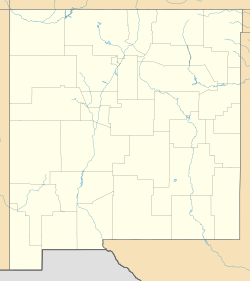Jemez River facts for kids
Quick facts for kids Jemez River |
|
|---|---|

The Jemez River, flowing downstream from Jemez Pueblo in November 2008.
|
|
|
Where the Jemez River meets the Rio Grande in New Mexico.
|
|
| Country | United States |
| State | New Mexico |
| County | Sandoval |
| Physical characteristics | |
| Main source | Confluence of San Antonio Creek and East Fork Jemez River Jemez Mountains 35°51′57″N 106°38′21″W / 35.86583°N 106.63917°W |
| River mouth | Rio Grande 35°22′9″N 106°30′52″W / 35.36917°N 106.51444°W |
| Length | 80 mi (130 km) |
| Basin features | |
| Basin size | 1,038 sq mi (2,690 km2) |
| Official name: Jemez (East Fork) | |
| Type: | Wild, Scenic, Recreational |
| Designated: | June 6, 1990 |
The Jemez River is a river in New Mexico, United States. It flows through Sandoval County and is a smaller river that joins a much larger one, the Rio Grande. Think of it like a smaller road that connects to a big highway!
Contents
What is the Jemez River Like?
The Jemez River starts when two smaller streams, the East Fork Jemez River and San Antonio Creek, meet. These streams collect water from the Jemez Mountains and the Santa Fe National Forest.
The Jemez River itself is about 50 miles (80 km) long. If you include its longest starting stream, San Antonio Creek, it stretches to about 80 miles (129 km). The East Fork Jemez River is about 22 miles (35 km) long.
Both San Antonio Creek and the East Fork Jemez River flow in interesting, curvy paths. The East Fork Jemez is special because it's part of the National Wild and Scenic Rivers System. This means it's protected for its natural beauty and importance.
The Jemez River generally flows south. It eventually joins the mighty Rio Grande near a town called Bernalillo, which is north of Albuquerque.
Where Does the Jemez River Flow?
The two main streams that form the Jemez River are San Antonio Creek and the East Fork Jemez River. Both of these streams begin on the west side of the Sierra de los Valles, close to Los Alamos County.
How San Antonio Creek and East Fork Jemez River Start
San Antonio Creek flows west, making a curve towards the north. It passes through two valleys called Valle Toledo and Valle San Antonio. The East Fork Jemez River flows west, curving towards the south, and goes through Valle Grande. All these valleys are part of a huge ancient volcanic crater called the Valles Caldera.
These two starting streams meet near a place called Battleship Rock. This meeting point is where the main part of the Jemez River officially begins.
Journey Through Canyons and Reservations
The Jemez River then flows south through the Cañon de San Diego. This canyon is nestled between the Jemez Mountains and the Nacimiento Mountains. The river continues its journey to Jemez Springs.
After Jemez Springs, the river keeps flowing south through the canyon. It meets another river, the Rio Guadalupe, near the towns of Cañones and Cañon.
From there, the Jemez River continues south and passes through the Jemez Indian Reservation. Here, some of its water is used to water crops in irrigation canals. Vallecito Creek joins the Jemez River near Jemez Pueblo.
A few miles further south, the Jemez River enters the Zia Indian Reservation. It is joined by the Rio Salado about four miles upstream from Zia Pueblo.
The river then gently bends southeast and enters the Santa Ana Indian Reservation. It flows past the Santa Ana Pueblo, which is at the upper end of the Jemez Canyon Reservoir. This reservoir was created by the Jemez Canyon Dam and is completely within the Santa Ana Reservation.
Below the dam, the Jemez River flows for about three more miles. Finally, it meets the Rio Grande, just a few miles north of Bernalillo.


